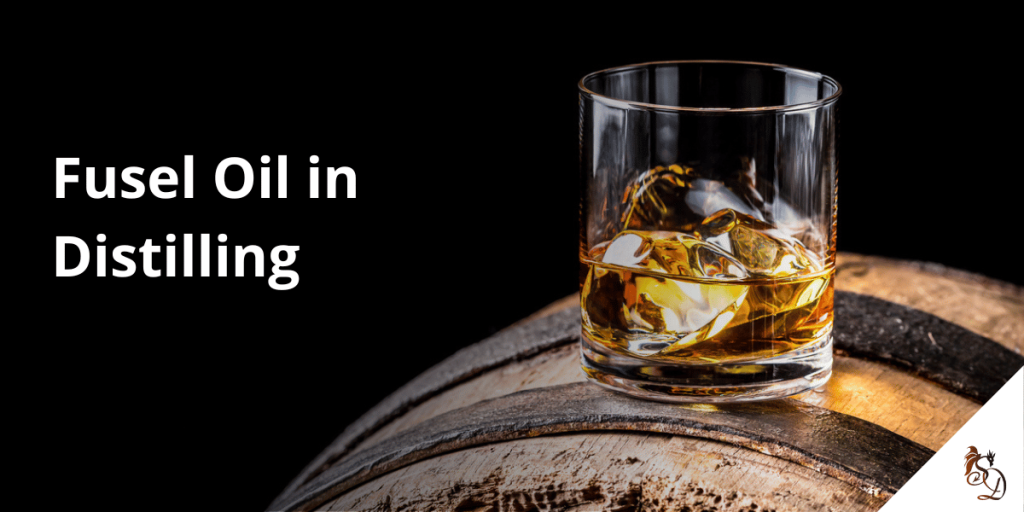Fusel Oil Talk

A friend of mine recently did this write up below and I think he did a very good job of spelling out some pretty requisite information. Without further adieu, this from SS:
How do I get rid of fusel oils in my spirits?
- Fusel alcohols or fuselol, also sometimes called fusel oils, are mixtures of several alcohols (chiefly amyl alcohol) produced as a by-product during alcoholic fermentation. The word “Fusel” is from the German word that means “bad liquor”
What different types of fusel alcohols are there?
Fusel alcohols can be classified into two different categories:
- Hazardous Alcohols
- Methanol (methyl alcohol), a poisonous compound (lethal dosage of 5628 mg/kg if consumed orally)
- Isopropanol (isopropyl alcohol), which is oxidized to form acetone by alcohol dehydrogenase in the liver
2. Congeners
- Some beverages, such as rum, whiskey (especially Bourbon), incompletely rectified vodka ( Siwucha for instance) and traditional ales and ciders, are expected to have relatively high concentrations of non-hazardous alcohols as part of their flavor profile.
- However, in other beverages, such cane vodka and beers (lagers specifically), the presence of alcohols other than ethanol is considered a fault.
Compounds involved are chiefly:
- 2-Methel-1-Butanol – sometimes called “active” Amyl Alcohol
- Isoamyl Alcohol (Isopentanol)
- Isobutyl Alcohol – one of the least toxic of the Butanols
- N-Propyl Alcohol
Where do fusel alcohols come from?
Fusel alcohols are always formed during fermentation, but the amount or concentration of Fusel Oils is increased dramatically if and when fermentation occurs:
- At higher temperatures (normally 22 degrees Celsius)
- At lower PH (too acidic)
- When yeast activity is limited by low nitrogen content (insufficient nutrients)
During distillation, most fusel alcohols are concentrated in the feints or “Tails” at the end of the distillation run. They have an oily consistency, which is noticeable to the distiller, hence the other name “fusel oil”. If desired, these heavier alcohols can be almost completely separated in an “adjustable reflux still” or “fractioning column”.
Do Fusel Oils cause hangovers?
A lot of people are of the opinion that fusel oils cause or contribute to hangovers. This is a matter of scientific debate. A Japanese study in 2003 concluded: “the fusel oil in whiskey had no effect on the ethanol-induced emetic response”. It must be said however, that the Japanese used the common Asian house shrew as a test subject, so you would not be blamed if you thought you “smelled a rat”. Still, the higher alcohols do certainly give me a headache (personal observation).
What are the facts about Fusel Oils?
Fusel oil is the common or encompassing name for by-products as well as higher alcohols formed in the fermentation process. It is therefore not a pure compound or compounds, but considered to be a mixture.
- The principal ingredient of fusel oil is amylalcohol which comprises 65-80% of fusel oil.
- It may also contain all forms of isobutylcarbinol and damylalcohol, and may contain between 15-25% of isobutyl, and approximately 4-7% of n-propyl alcohol.
- Amyl-, butyl- and propylalcohols therefore form the bulk of fusel oils.
- Other substances are present, although none in significant quantities – the amounts are in fact so small that one needs only consider the principal compounds when doing an analysis.
The figures above cover quite a range ( 65 to 80%, 15 to 25% and 4 to 7%)
The actual make up of fusel oil depends principally on the ingredients of the fermentation, the fermentation temperature, and to a lesser extent the fermentation variables like pH and nutrients.
Why would fusel oils be desirable in spirits?
Fusel oil is the aroma of the mash. For example, in brandy and other fruit-based spirits (for example Slivovitz, Calvados, Rakia, Palinka, Palene, Piore Williams, etc.) The fusel oil in the final product is normally 0.6% or more. This is the principal aroma of the spirit, and after storage and maturing, most fusel oil constituents are converted to esters. However, even the basic raw spirit distilled from a sugar wash, the fusel content can be between 0.4-0.7% of the 95% alcohol.
The type of fermentation is therefore no indication or guarantee that you will or will not produce large quantities of fusel oils.
Can I reduce Fusel Oil formation during fermentation?
The addition of ammonium salts to a fermentation reduces the formation of fusel oil. This is referred to as “Yeast Nutrient Salt” (normally Di-Ammonium Phosphate, or DAP), a common ingredient of yeast nutrients. In addition, fermenting at lower temperatures for a longer period of time should also form less fusel oils.
Can I remove Fusel Oils from my distillate?
When spirits are diluted down to 40-50%, some of the fusel oil will far out of solution, and take on an oily consistency. This is amplified if the solution is kept cool, either by use of a cooling jacket, cooling coils, or refrigeration panels in a holding tank on the commercial level. The fusel oils that separate out are the insoluble fusel oils, principally Amylalcohols. The separated fusel oils float up to the surface due to its lower specific weight, where it can be removed by various methods.
At the amateur level this could be as simple as dabbing with an absorbent paper on a tissue, or even filtering through coffee filters. Commercially you would use a paper plate filter and or chilled filtration. Or for continuous distillation, the use of a decanter in order to create on the fly stratification. Think oil separator.
As long as the temperature is below 15°C and effective filtering is used, you should be able to separate approximately 0.3% of the fusel oil (15 ml of 5 liters of spirits) calculated on 95% ABV spirits. This should be more than 1/3 of the fusel oil present. If needed, the results can then be further purified using activated carbon filtration, although at the hobby level, this should really not be necessary.
